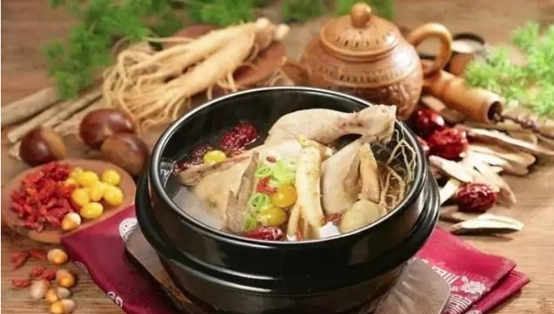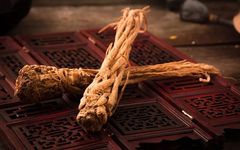Angelica Sinensis, also known as Dang Gui, has several aliases including Dang Gui Fen, Gan Gui, Ma Wei Dang Gui, Qin Na, Ma Wei Gui, Yun Gui, Xi Dang Gui, and Min Dang Gui.According to the Chinese Pharmacopoeia, Angelica Sinensis is sweet and pungent in flavor, and warm in nature. It enters the Liver, Heart, and Spleen meridians. Its functions include nourishing blood, invigorating blood circulation, regulating menstruation, alleviating pain, and moistening the intestines to relieve constipation. It is used for blood deficiency leading to pale complexion, dizziness, palpitations, irregular menstruation, amenorrhea, dysmenorrhea, abdominal pain due to deficiency and cold, dry intestines leading to constipation, rheumatic pain, trauma from falls, and carbuncles or ulcers. When prepared with wine, Angelica Sinensis invigorates blood and regulates menstruation, making it suitable for amenorrhea and dysmenorrhea, as well as rheumatic pain and trauma. The recommended dosage is 6-12g.

Image Source: Shetu NetworkIn November 2019, the State Administration for Market Regulation issued an announcement (No. 8 of 2019) approving the inclusion of Angelica Sinensis and five other substances in the list of materials that are both food and medicinal. Ingredients that are dual-purpose not only contain essential nutrients required by the human body, such as proteins, fats, sugars, vitamins, and minerals, but also contain complex compounds that treat and prevent chronic diseases, providing multi-faceted and multi-pathway restorative effects. Due to their dual role as both food and medicine, they are favored by food development companies.
The announcement issued by the State Administration for Market Regulation (No. 8 of 2019)

 Regulatory Standards for SpicesAmong the currently approved list of 93 dual-purpose substances, about 20 have the role of spices and seasonings, commonly used in everyday food and cooking.According to the national standard GB29938-2013, which defines the general rules for food flavoring agents, natural flavoring agents are preparations obtained from plant and animal materials through physical methods, enzymatic methods, or microbial methods. These materials can be unprocessed or processed through traditional food preparation techniques, including essential oils, fruit juice oils, extracts, protein hydrolysates, distillates, or products obtained through roasting, heating, or enzymatic hydrolysis.Angelica Sinensis can be used as a spice and seasoning in various forms, including dried, sliced, or powdered, as well as in water extracts, alcohol extracts, or extracts using other solvents permitted by regulations.
Regulatory Standards for SpicesAmong the currently approved list of 93 dual-purpose substances, about 20 have the role of spices and seasonings, commonly used in everyday food and cooking.According to the national standard GB29938-2013, which defines the general rules for food flavoring agents, natural flavoring agents are preparations obtained from plant and animal materials through physical methods, enzymatic methods, or microbial methods. These materials can be unprocessed or processed through traditional food preparation techniques, including essential oils, fruit juice oils, extracts, protein hydrolysates, distillates, or products obtained through roasting, heating, or enzymatic hydrolysis.Angelica Sinensis can be used as a spice and seasoning in various forms, including dried, sliced, or powdered, as well as in water extracts, alcohol extracts, or extracts using other solvents permitted by regulations. 
Application of Angelica Sinensis — Medicinal Cuisine
The concept of dual-purpose food and medicine implies that these medicinal substances can be used in ordinary food. Like other Chinese herbs, Angelica Sinensis is a commonly used spice, not only for its unique medicinal aroma but also for its health benefits in traditional Chinese medicine. Therefore, to effectively use dual-purpose seasoning, one must understand both its flavor characteristics and its medicinal properties. Medicinal cuisine, simply put, is the combination of medicinal ingredients with food ingredients to create delicious dishes. This practice originated from China’s traditional dietary and TCM dietary therapy culture, representing an important component of TCM, combining traditional medical knowledge with culinary experience. Medicinal cuisine is the most common application of dual-purpose ingredients, and many restaurants focusing on health product development create various nourishing soups and exquisite dishes incorporating these ingredients. Angelica Sinensis is the most frequently used component in medicinal cuisine.

Angelica Sinensis synergizes with other dual-purpose ingredients: 1. Angelica Sinensis, Codonopsis Pilosula, and Chinese Yam Pork Kidney. Ingredients: 10g Angelica Sinensis, 10g Codonopsis Pilosula, 10g Chinese Yam, 500g Pork Kidney, utilizing three dual-purpose ingredients: Angelica Sinensis, Codonopsis Pilosula, and Chinese Yam.2. Angelica Sinensis and Rehmannia Chicken Stew. Ingredients: 15g cooked Rehmannia, 15g Angelica Sinensis, 5g fried White Peony Root, 1 chicken leg, 5g salt. Main effects: Nourishing blood and yin, strengthening the body. Suitable for excessive menstrual bleeding, and other related conditions.3. Angelica Sinensis and Ginger, each 9g, with 250g Lamb. Cook the meat with the medicinal juice. Used for treating postpartum abdominal pain.4. Peach Kernel and Angelica Sinensis: Both can invigorate blood circulation and regulate menstruation, moistening the intestines to relieve constipation, treating gynecological blood stagnation, amenorrhea, dysmenorrhea, postpartum abdominal pain, and trauma-related swelling and bruising.5. Notoginseng and Angelica Sinensis: Both are sweet and warm in nature, entering the Liver and Heart meridians, and can invigorate blood and alleviate pain, treating trauma-related swelling and abdominal pain due to blood stasis. Different parts of Angelica Sinensis have different health benefits; the root is best for blood nourishment, the tail for invigorating blood, and the whole herb for overall nourishment. Angelica Sinensis is divided into three parts: the head, body, and tail. Depending on the processing method, it can be soaked in wine, stir-fried, or carbonized. Angelica Sinensis can be used raw or after processing.  Application of Angelica Sinensis — Functional FoodsThe combination of Astragalus and Angelica Sinensis has been used in traditional Chinese medicine for over 3,000 years. The Angelica Sinensis Blood Nourishing Soup combines Astragalus and Angelica Sinensis in a 5:1 ratio, providing qi and blood nourishing effects, commonly used for treating internal injuries from fatigue, qi and blood deficiency, and external heat due to deficiency. According to traditional TCM theory, Astragalus can increase a person’s “qi” (life energy), while Angelica Sinensis nourishes the “blood” (body circulation). Angelica Sinensis has a strong medicinal aroma, initially sweet, followed by a numbing sensation, and can be used like Sichuan pepper. It is commonly used in medicinal brine. Astragalus: for exterior deficiency with spontaneous sweating, yin deficiency with night sweats, acute nephritis with edema, and qi deficiency. It has a sweet taste and can eliminate fishy odors! Angelica Sinensis, Astragalus, and Codonopsis Pilosula, each 15g, decocted in water can be used to treat anemia-related qi and blood deficiency, dizziness, fatigue, and pale complexion. Angelica Sinensis and Astragalus are often used in Chinese cuisine or as ingredients in functional foods. A recent clinical study conducted by Kaohsiung Medical University in Taiwan indicates that the traditional Chinese medicine Angelica Sinensis Blood Nourishing Soup (DBT), formed by the combination of Astragalus and Angelica Sinensis, can shorten exercise time and increase iron content during recovery.
Application of Angelica Sinensis — Functional FoodsThe combination of Astragalus and Angelica Sinensis has been used in traditional Chinese medicine for over 3,000 years. The Angelica Sinensis Blood Nourishing Soup combines Astragalus and Angelica Sinensis in a 5:1 ratio, providing qi and blood nourishing effects, commonly used for treating internal injuries from fatigue, qi and blood deficiency, and external heat due to deficiency. According to traditional TCM theory, Astragalus can increase a person’s “qi” (life energy), while Angelica Sinensis nourishes the “blood” (body circulation). Angelica Sinensis has a strong medicinal aroma, initially sweet, followed by a numbing sensation, and can be used like Sichuan pepper. It is commonly used in medicinal brine. Astragalus: for exterior deficiency with spontaneous sweating, yin deficiency with night sweats, acute nephritis with edema, and qi deficiency. It has a sweet taste and can eliminate fishy odors! Angelica Sinensis, Astragalus, and Codonopsis Pilosula, each 15g, decocted in water can be used to treat anemia-related qi and blood deficiency, dizziness, fatigue, and pale complexion. Angelica Sinensis and Astragalus are often used in Chinese cuisine or as ingredients in functional foods. A recent clinical study conducted by Kaohsiung Medical University in Taiwan indicates that the traditional Chinese medicine Angelica Sinensis Blood Nourishing Soup (DBT), formed by the combination of Astragalus and Angelica Sinensis, can shorten exercise time and increase iron content during recovery.
Special Statement
The characteristics and effects of the products/ingredients mentioned in this article represent the views of the relevant companies, interviewees, or the original journals and media. Herbridge only conveys this information for informational purposes and does not represent our absolute endorsement of the claims. We also do not support the sale of any products.
END




Discover More Exciting Content
Follow Natural Ingredients

>>> Statement*Herbridge indicates original articles; for reprints, please add WeChat Amy (18192486835).*The images inserted in the article do not involve commercial behavior and are for communication purposes only; sources are indicated; images without sources are sourced from the internet. If there is any infringement, please inform us for deletion. Contact email: [email protected]

